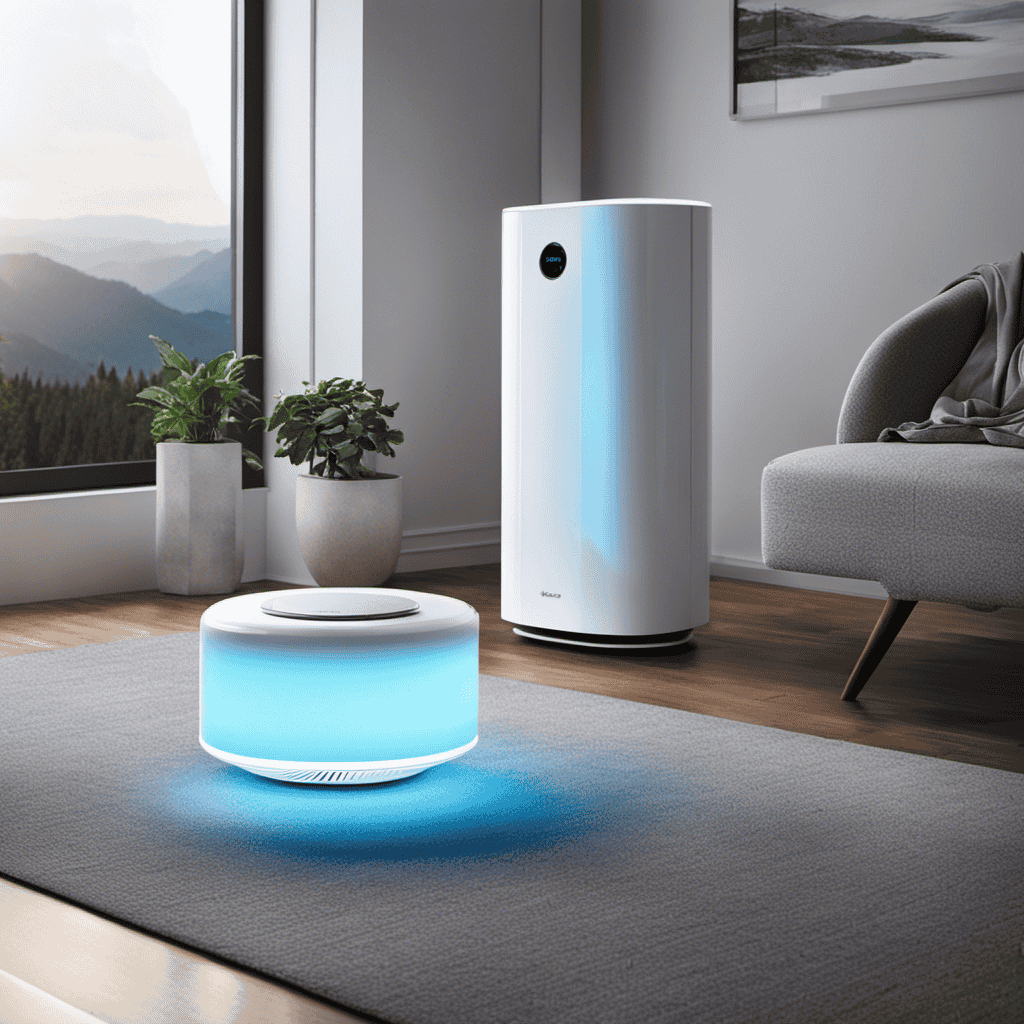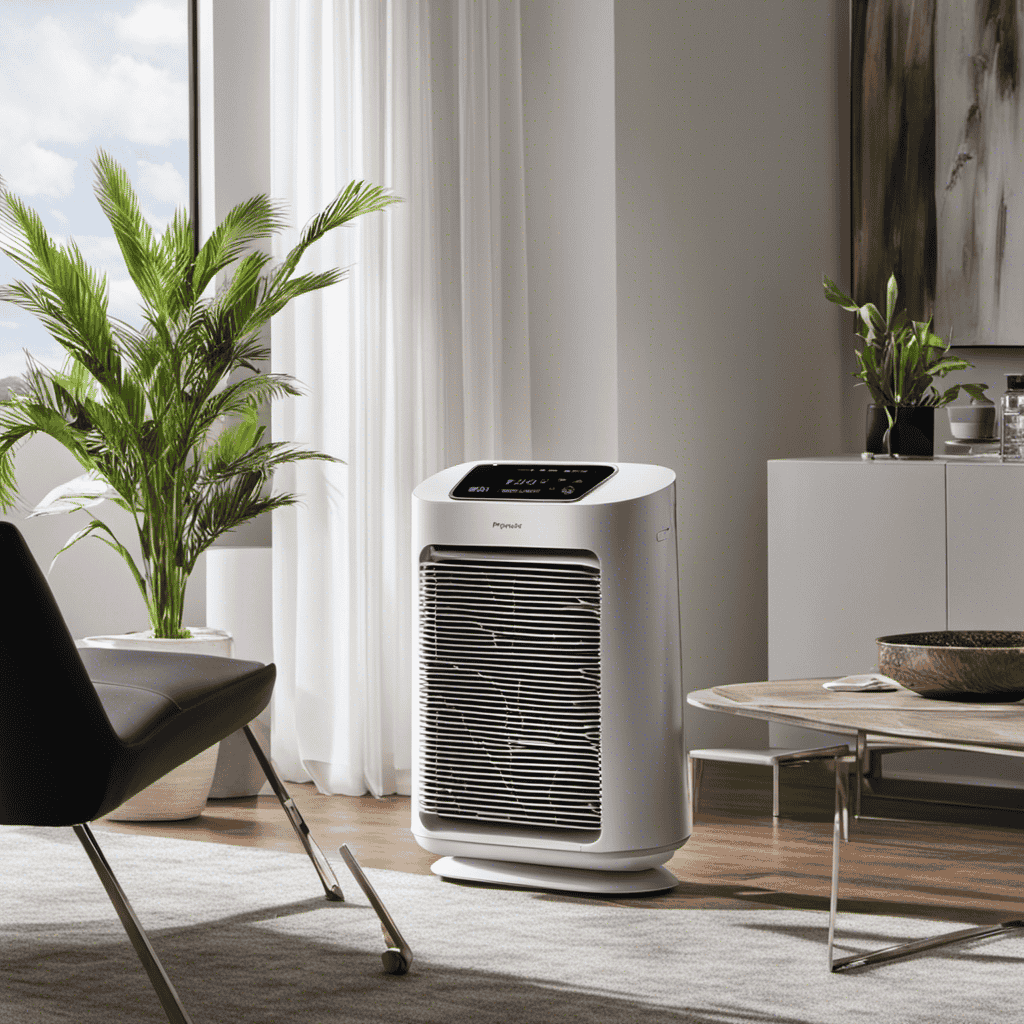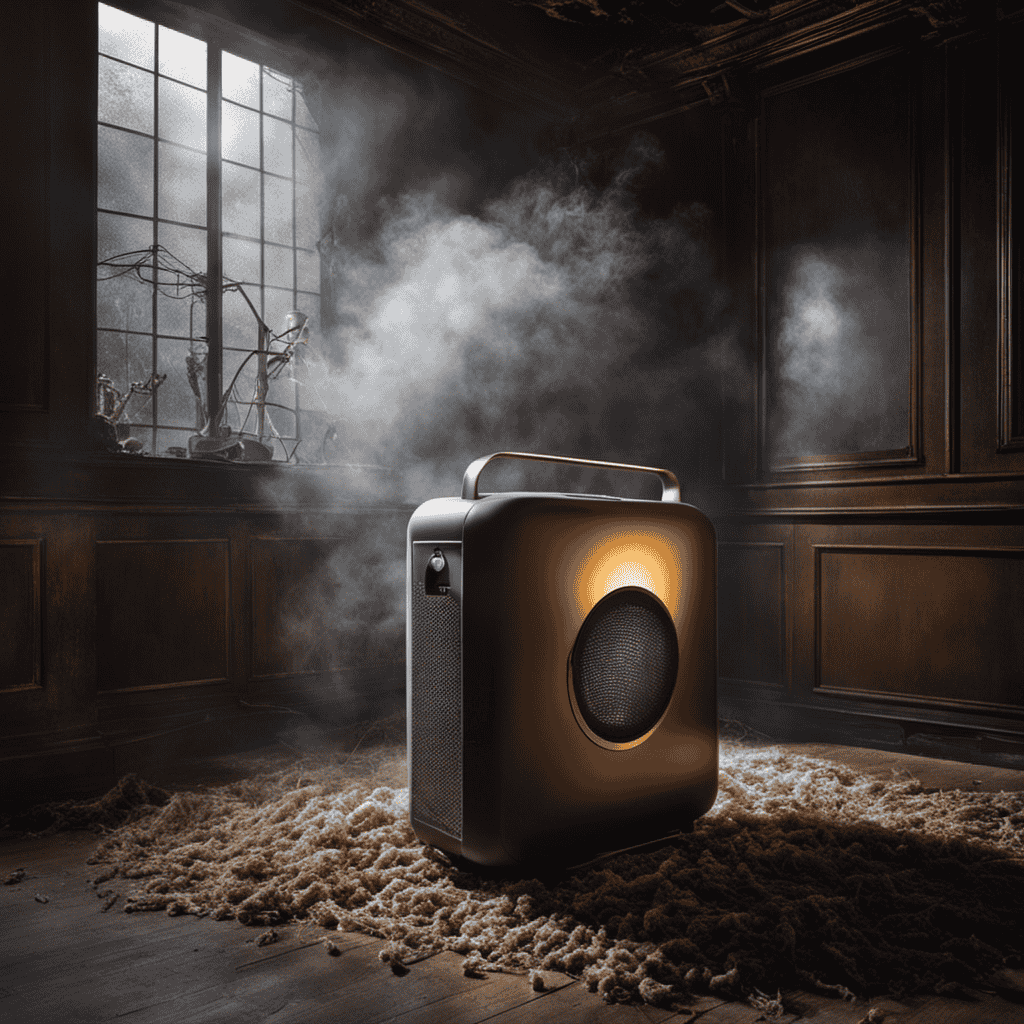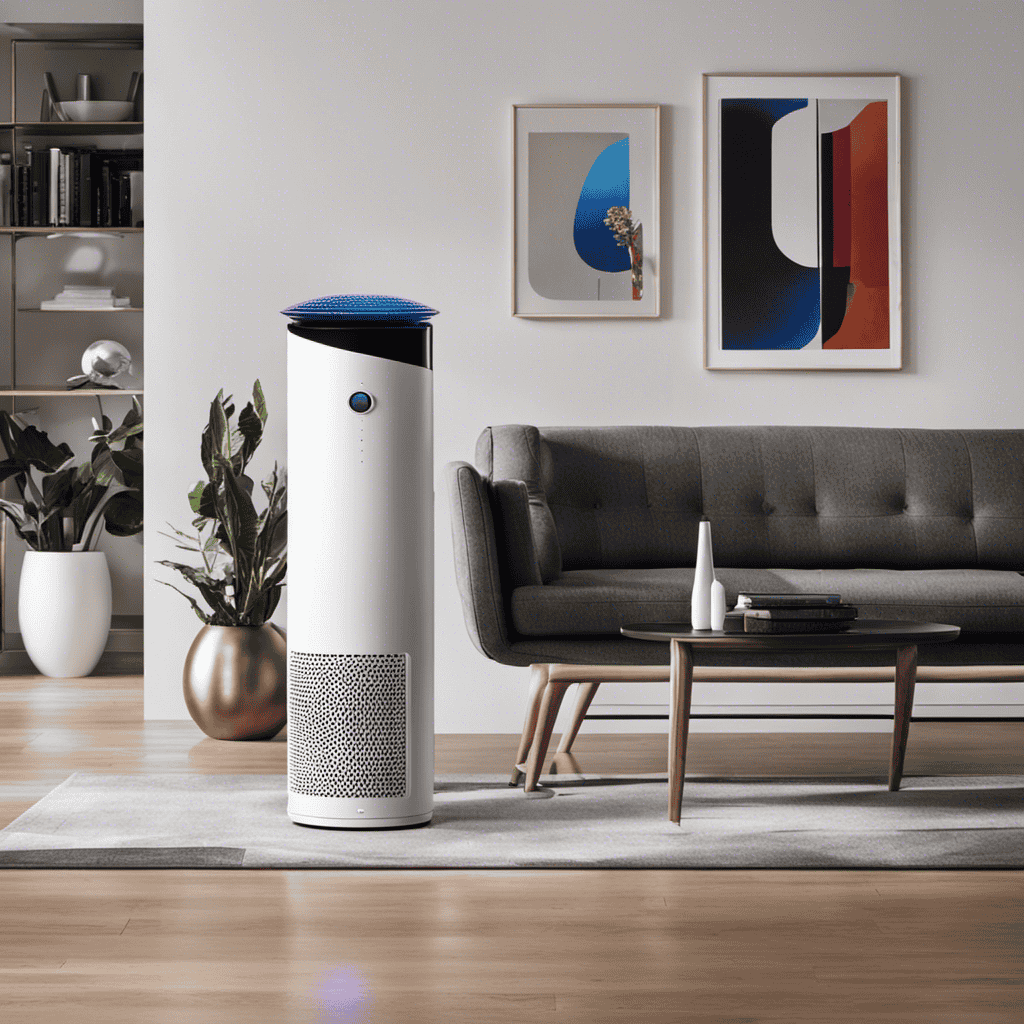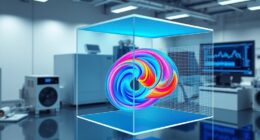As someone who depends on an air purifier to purify the air in my home, I frequently question whether it is actually working effectively. With numerous models and performance measures to take into account, evaluating the efficiency of my air purifier can be quite challenging.
However, fear not! In this article, I will guide you through the process of understanding air purifier performance, monitoring air quality levels, and conducting DIY tests to ensure that your air purifier is indeed doing the job it’s supposed to do.
Let’s dive in!
Key Takeaways
- Familiarize yourself with air purifier performance metrics, such as multiple filtration stages and Clean Air Delivery Rate (CADR) ratings.
- Monitor air quality levels to accurately assess the presence of indoor air pollutants and determine the effectiveness of your air purifier.
- Regularly assess the efficiency of your air purifier by comparing air quality before and after using the device and conducting proper maintenance.
- Look for common signs of an effective air purifier, such as a decrease in airborne allergens, a fresher smell in your space, and a longer lifespan of filters.
Understanding Air Purifier Performance Metrics
To understand if your air purifier is doing the job, you should familiarize yourself with the performance metrics.
Evaluating air purifier filtration is crucial in determining its effectiveness. Look for purifiers that have multiple filtration stages, including a pre-filter, HEPA filter, and activated carbon filter. These filters work together to capture different types of pollutants, such as dust, pollen, pet dander, and odors.
Additionally, comparing air purifier CADR (Clean Air Delivery Rate) ratings can help you gauge its efficiency in removing airborne particles. The CADR rating measures the volume of clean air a purifier can deliver in a specific amount of time. A higher CADR rating indicates a more powerful and efficient air purifier.
Monitoring Air Quality Levels
Monitoring air quality levels is essential to ensure that your air purifier is effective. By regularly checking the air quality in your home, you can determine if your air purifier is effectively removing indoor air pollutants that can have detrimental health effects. Here are three reasons why monitoring air quality levels is crucial:
-
Accuracy: Monitoring air quality levels allows you to accurately assess the presence of indoor air pollutants, such as allergens, dust particles, and volatile organic compounds (VOCs). This helps you understand the effectiveness of your air purifier in reducing these harmful substances.
-
Timely intervention: Regular monitoring enables you to identify any sudden spikes or significant changes in air quality. This allows you to take prompt action, such as adjusting the settings on your air purifier or addressing potential sources of pollution, to maintain a healthy indoor environment.
-
Long-term effectiveness: Continuous monitoring helps you track the long-term performance of your air purifier. It provides valuable data on how well the device is functioning over time, allowing you to make informed decisions about maintenance or replacement.
Assessing the Efficiency of Your Air Purifier
Assessing the efficiency of my air purifier can be done by comparing the air quality before and after using the device. Regular air purifier maintenance is crucial to ensure optimal performance. This includes cleaning or replacing filters, checking for any blockages, and keeping the unit in a well-maintained condition.
When selecting the right air purifier model, it is important to consider the specific needs of your space. Factors such as room size, allergies, and pollutants present should be taken into account. Look for models with high Clean Air Delivery Rate (CADR) and consider additional features like activated carbon filters for odor removal or UV-C light for germicidal action.
Identifying Common Signs of an Effective Air Purifier
You can easily identify common signs of an effective air purifier by noticing a significant decrease in airborne allergens and a fresher, cleaner smell in your space. Here are three key factors to consider when evaluating the effectiveness of your air purifier:
-
Filter Lifespan: Evaluating the lifespan of the filters is crucial as it determines how long the air purifier can effectively remove pollutants from the air. Compare different air purifier brands to find one with long-lasting filters that require minimal maintenance.
-
Airborne Allergen Reduction: An effective air purifier should noticeably reduce the presence of common allergens such as dust, pollen, and pet dander. Regularly monitor the air quality in your space to see if the air purifier is effectively capturing and eliminating these allergens.
-
Fresh, Clean Smell: A good air purifier should leave your space smelling clean and fresh. If you notice a significant improvement in the odor of your environment, it is a positive sign that the air purifier is doing its job effectively.
Conducting DIY Tests to Evaluate Air Purifier Effectiveness
To determine the effectiveness of your air purifier, try conducting DIY tests at home. Monitoring the air quality in your living space is crucial, especially if you suffer from indoor allergies or want to reduce air pollution. By conducting these tests, you can ensure that your air purifier is doing its job effectively. Here is a table with three simple tests you can perform:
| Test | Procedure |
|---|---|
| Particle Count Test | Use a particle counter to measure the number of particles in the air before and after running the air purifier. A significant decrease in particle count indicates good filtration efficiency. |
| Odor Test | Introduce a strong odor, like cooking fumes, into the room and observe how quickly the air purifier removes the smell. A fast elimination of odor suggests effective filtration. |
| Allergy Relief Test | Monitor your allergy symptoms in the presence and absence of the air purifier. Reduced symptoms indicate that the purifier is successfully removing allergens from the air. |
Frequently Asked Questions
Can an Air Purifier Completely Eliminate All Pollutants From the Air?
An air purifier cannot completely eliminate all pollutants from the air. While it can be effective in reducing certain pollutants, it has limitations in removing all types of pollutants, such as gases and odors.
How Often Should I Replace the Filters in My Air Purifier?
How often should I replace the filters in my air purifier? Regular air purifier maintenance is crucial to ensure optimal performance. Look out for signs of a clogged air filter, such as reduced airflow and decreased efficiency.
Can an Air Purifier Help With Allergies and Asthma?
An air purifier can be effective in reducing allergens and irritants in the air, providing benefits for those with allergies and asthma. It filters out particles and improves air quality for better respiratory health.
Can I Use Multiple Air Purifiers in My Home for Better Air Quality?
Using multiple air purifiers in different rooms can improve air quality throughout your home. However, it’s important to consider the size of the rooms and the purifiers’ coverage area.
Is It Safe to Leave My Air Purifier on All the Time?
Leaving the air purifier on constantly is safe, but it’s important to consider the noise level and energy consumption. Regularly check the filters and monitor air quality to ensure the purifier is effectively doing its job.
What Are the Signs That Indicate My Air Purifier Is Effective?
When assessing an air purifier’s efficiency, consider the CADR, or Clean Air Delivery Rate, and ACH, or Air Changes per Hour. Check for HEPA filtration and Energy Star certification to ensure optimal performance. Refer to an air purifier buying guide for more details on selecting an effective unit.
Conclusion
In conclusion, determining whether your air purifier is doing its job is a matter of utmost importance. With the use of various performance metrics, monitoring air quality levels, assessing efficiency, and identifying common signs of effectiveness, you can rest assured that your air purifier is working wonders in purifying the air you breathe.
Conducting DIY tests further solidifies its effectiveness, leaving no room for doubt. So, fear not, for your air purifier is a mighty force, battling and defeating all pollutants, ensuring only the purest air for your lungs.

